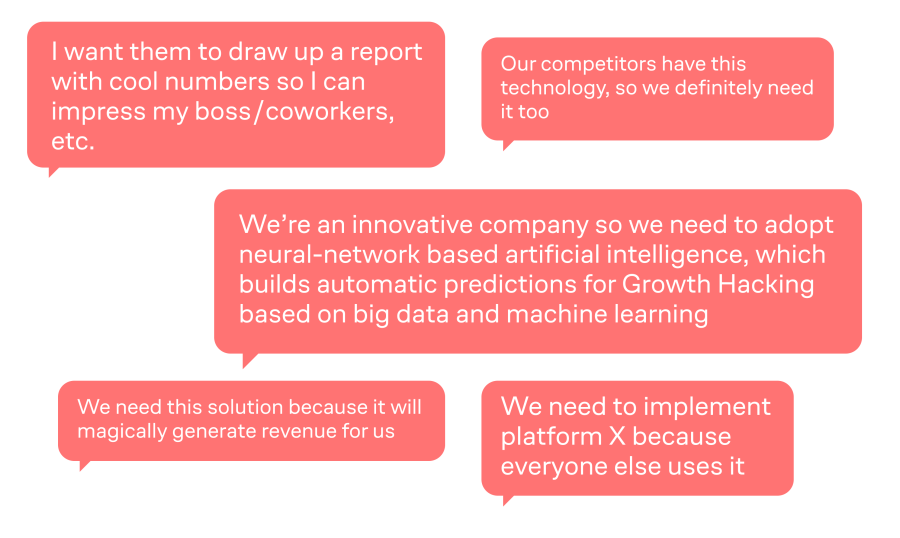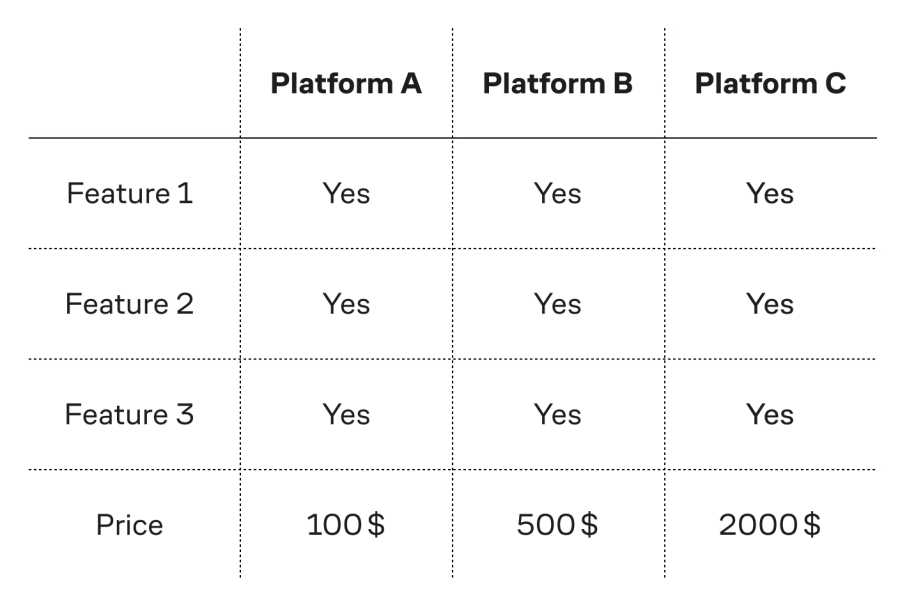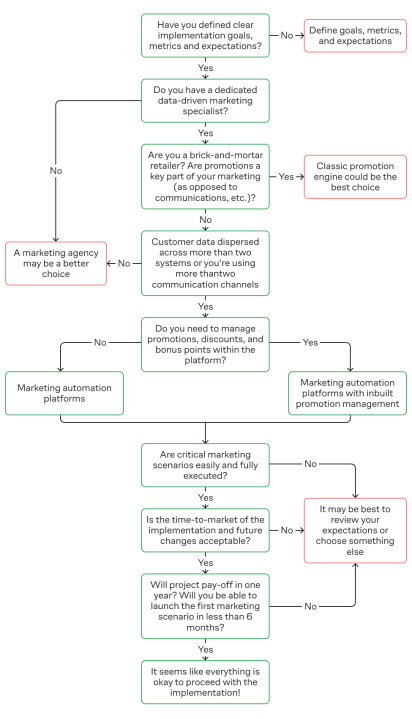
Personalization platforms are a new must-have for all businesses, but sometimes they look like a Christmas tree covered with decorations. To help everyone who has experienced this pain, here is a how-to guide for choosing a retail personalization platform.
In this article, I will share my opinion about why marketing personalization has become so popular, what principles should be followed when choosing a personalization platform, and what a typical decision tree might look like.
Why marketing personalization is so popular
Nobody likes spam and unnecessary offers. However, spam, robotexts, and robocalls will increase dramatically in 2023. If a store makes marketing at least a bit more human by remembering previous purchases and personalized messages, the customers’ attitude towards it changes. This approach is often called “human2human marketing” or “marketing with a human face.” This means: do not spam; do not pressure a buyer; help them make an informed choice based on personalization.
Below is the data I’ve collected on the added revenue from personalized campaigns among Mindbox clients. The dark green bar is the lowest added revenue among the companies in a particular industry. The light green bar is the highest one.
For example, newsletter personalization can add 3-16% in revenue among retailers selling home goods and furniture.
When brands realized the potential of personalization, the marketing tech sector exploded.
The number of martech companies increased from 150 in 2011 to 9.9 thousand in 2022.
There are now so many viable technologies to pick from, each with its own functions and merits.
So, how do you choose the right personalization technologies without losing your mind
Marketing personalization (automation) technology is a complex tool. Be ready for the fact that the preparation and selection of a platform will take longer than implementation.
Here are my top five tips for successful implementation:
- Formulate the implementation goal: a metric of success and expectations for it. Decide who will use the tool and if such people are in your company.
- Describe examples of scenarios for using the technology.
- Decide if you need customer data integration.
- Estimate the speed of implementation and changes.
- Estimate the ROI.
Principle 1. Formulate a metric of success and outline your expectations for it
The goal of platform implementation is the most important. If your team cannot agree on a clearly defined goal, you’ll never reach success. So it’s better to postpone the purchase of automation technology until everyone is aligned. Strong goals include success metrics, timelines, and a chain of responsibility that everyone agrees on.
Essential points about the metric
- Agree on the method of calculation. Make sure that it is challenging to simulate its achievement without seeing real benefits.
- Formulate expectations for the metric. A metric without expectations doesn’t work.
For example, the team implements a website personalization technology and makes a statement about success: Conversion has increased by 0.5%. What is this measured against? Is this a large or small amount?
Examples of bad or ineffective metrics
- Revenue growth from an email channel measured by Google Analytics’ last-click attribution model
This metric is easy to inflate: improve the campaign design and the number of emails sent. Sometimes this is precisely what is hidden behind flashy terms like “growth hacking.” You will receive more orders attributed to the email channel using this metric.
The reason for the apparent growth in this case is traffic redistribution. Customers will often visit the website using a link from an email with a new design rather than typing a URL or using a search engine.
The changes may not affect the turnover and marginality of the business.
- Share of customers who are members of the loyalty program or a higher average order value from members of the loyalty program
Real-life example: A chain of canteens inside business centers has implemented a loyalty program. Both metrics show excellent growth, but the company’s turnover and revenue are not increasing. Why is this happening?
The problem is that no new customers have appeared in the canteens since people from the outside simply cannot get there. The same employees from the same business centers continue to go to the canteens that they used to go to before. Only now, the audience has been divided into layers—people who spent more money registered in the loyalty program first. As a result, both metrics look rather good.
The number of program participants is growing, and the average check per participant is higher than for ordinary customers. However, there are no real benefits for the business. Moreover, there are drawbacks. The marginality of sales fell because regular customers began to buy at a discount.
Look at examples of good metrics
The examples below qualify as good measurements because it’s easy to quantify the results and challenging to inflate or misrepresent them.
United Colors of Benetton used this metric and looked at segment creation, increase in conversions and average order value to measure progress. INCANTO looked at automated recommendations based on consumer behavior to track this.
Reducing the company’s workload is the primary thing that affects this metric, as shown in the cases of Burger King and Olant. Another factor that impacts these results is reducing total marketing costs, see United Colors of Benetton.
-
Increasing transparency and rate of change
Here, the use of control groups and the number of new monthly campaigns are the two main factors that can influence this goal. Flower delivery service Blossom Flower Delivery leveraged both of these to get real, quantifiable data to improve their processes.
Examples of well-defined goals
| I want to | In order to | This will | In | Up to |
| Implement X technology | Launch 50 new triggered campaigns | Drive email revenue increase | 6 months | 10% |
| Implement Y technology | Decrease number of discounts issued to customers | Drive Revenue margin | 6 months | 5% |
| Implement Z technology | Decrease IT & email marketing team workload while launching new campaigns | Decrease man hours spent on email marketing | 3 months | 80 manhours per month |
Examples of ineffective goals

- Ineffective goals
Such goals in practice can mean that the team or a particular marketer does not really understand what to do.
Principle 2. Describe use cases
Are you familiar with the situation in the table below?
This is a classic situation when a large company tries to compare several technologies. Sometimes completely different ones. A giant table is created, sometimes containing several hundred lines, where different departments enter their functionality “wish list.”
Unfortunately, the final decision about which platform to use is often left to the people who are either too busy or unqualified. As a result, they fill out comparative tables based on shallow information like basic presentations or site descriptions. Sometimes they even ask contractors to fill out the tables for them.
However, even in a best-case scenario where everyone is qualified, does great research and creates a high-quality table, there’s still a high probability that it won’t lead to a good choice.
Business Examples of Well Define Goals and Metrics
Imagine you are an advanced marketer: You want to build RFM segments and launch targeted campaigns and promotions based on them. This requires technology, so you decide to do a side-by-side comparison of platforms that each perform very different overall functions:
- One is a gateway for email campaigns;
- Another is a niche technology, such as a big data trigger service;
- The third is a marketing automation system.
When you look at the line “Ability to send campaigns by RFM segments,” all three are marked “yes.” Thus, at first glance, it seems the question of choice comes down to price.
However, there’s a problem: What did they really mean by “Yes?”
- The specialists presenting the gateway for email campaigns assumed that you would collect data on your side, clean it up, segment it, then send a list of email addresses, newsletter templates, and related data to the gateway for each segment.
- Colleagues from the big data trigger platform meant they would utilize their programmers according to your wishes, e.g., writing a code that segments data and sends campaigns.
- The employees of the marketing automation platform meant that their task was to provide a user-friendly design interface in which your marketer would build segments and launch campaigns with a manager who would help integrate and use the platform.
Therefore, you need to decide whether a particular technology suits you based on an assessment of use cases and not on functionality comparisons.
What if you formulate the “wish list” in the form of a workflow
Workflow 1: Our programmers developed a system that counts RFM. I just want to email address lists corresponding to the desired segments.
Solution: An inexpensive email gateway is better suited for the workflow.
Workflow 2: I want to try making targeted campaigns for RFM segments, but I don’t really understand what effect it will give or how it should be done, and I definitely won’t do it by myself.
Solution: You need an agency or a niche service that will quickly and cheaply do everything for you ‒ with a certain degree of transparency.
Workflow 3: I regularly recalculate and edit RFMs. The segment is used for email, SMS, mobile push notifications, and promotions. Each time a new marketing mechanic is launched takes a lot of time from analysts and programmers; it just doesn’t make sense!
Solution: An automation platform is needed here.
A list of workflows (future marketing campaigns) is critically important for making a conscious choice.
Ask potential candidate platforms to do the following:
- Evaluate workflows that are important to you and show implementation in each platform (for example, in a trial version). This way you will understand which product is suitable for your tasks. After, you can filter out companies that cannot help you conveniently or effectively reach your goals.
- Provide contacts of three to five companies (ideally from your industry) that have already implemented similar workflows on the chosen platform. Make sure that your needs are likely to be achieved based on their experience.
I have also prepared a list of essential things to consider when choosing an automation platform.
Principle 3. Think about data integration
Companies that sell their products across online and offline outlets or use several different channels of communication with their customers face a problem called “data integration.”
Customer information is spread piecemeal across several systems and databases, often with considerable overlap.
Buyers’ personal data, behavioral data, purchase history, and promotional points are stored in any or all of the following locations:
- The accounting system of retail points of sale;
- The website database;
- The platform for managing commodity promotions and bonus points;
- The CRM.
- Email services: campaigns, open rate, click rate, emails;
- Gateways: SMS, push notifications with similar data;
- The website: views of products and categories, cart, tags;
- Google Analytics: traffic sources, sessions, tags;
- Call center systems;
- Niche personalization services: your own specific pieces of data.
Synchronization of all of this is not a trivial exercise
First, you have to cleanse and unify customer data. This process should consider possible errors and typos in the full name, cities, and addresses, and the confirmation of contact information (email and phone number). It must also be secure so that when combining the two records, access to the account with the loyalty program bonus points does not get into another person’s hands.
Next, relevant information from different systems should be collected, classified, and merged around this “cleansed” record, e.g., what product a person clicked on in the email, what they looked at on the website, what they bought in the end, how much it cost, how they used bonus points, and so on.
Changing data for a specific person
Ideally, when changing data for a specific person, it is necessary to recalculate the segments they were previously placed in and use common sense when changing communications tactics. For example, after combining duplicates in the database, two supposedly different customers who made a single purchase may now be a single loyal customer with a much higher average order value. This is good news for you, but you do not want to immediately send them an email with promotions and discounts on expensive goods if they received completely different offers to one of their accounts before that.
All of this should work in real-time on large amounts of data (hundreds of millions of events for an average retailer), and it should be possible to manage external systems such as gateways or website personalization technologies.
Data cleansing
Data cleansing and unification (and its sequences for business) is a complex thing from a technical, marketing, and business point of view. Because of this, data integration and systems often don’t receive the attention needed. Instead, businesses simultaneously buy and launch separate niche personalization services, which leads to chaos.
All of the above systems should coexist in harmony with one another
Do you regularly face the following situations?
- You get an offer to buy something at a promotional price, but when you click on the link, you find out, “Oh, this promotion is not available for online customers.”
- You cannot use bonus points from the loyalty program on the website.
- You receive campaigns promoting products that are out of stock, or the prices in the email don’t correspond to the actual ones.
- The store is chasing you with retargeting and social media ads, even though you’ve already bought the product from the store.
- You receive conflicting offers in different channels: for example, a discount in an email, and at the same time a “buy one, get one free” (BOGO) campaign via SMS.
All these are different manifestations of “integration chaos.”
Algorithms
The second, less obvious consequence of ignoring the importance of data is how it affects the usefulness of the algorithms, big data, and neural networks that so many rely on. Algorithms and big data are susceptible to data quality. If you feed them with fragmented and unclean data, the results will be fragmented, messy, and unusable.
The highest efficiency of automated product recommendations, for example, from Amazon, is associated with a large array of uniform, clean, and reliable data that the retailer has collected for many years.
Data integration is the cornerstone of meaningful and effective personal marketing. Without it, there is no point in investing in personalization tools – the result will likely be random.
The problem of effective data integration is so essential that a separate class of platforms to solve this problem was created: the CDP, or customer data platform. In the United States, the market for such systems is one of the fastest-growing, with the CDP Institute forecasting CDP industry revenue will reach $2.3 billion in 2023.
Therefore, if you are:
- A company with online and offline points of sale;
- Using several channels of communication with customers;
- Building a complex, personalized communication, and discount scheme;
- Planning to actively use big data algorithms;
Data integration is essential
Be sure to take time to evaluate the CDP functionality on the platforms you are going to choose. Information on how to consider your options can be taken from this file.
As for interesting resources that talk about CDP (and where there is a directory of platforms, for example), I recommend cdpinstitute.org.
One of the relatively new trends in this industry is the emergence of integrated Customer Engagement Platforms (such as Mindbox). Platforms solve not only the problem of centralizing data, but also include marketing engagement tools. Such a products can significantly reduce the cost of marketing technology and accelerate the marketing team’s productivity by streamlining time-to-market hypotheses and new workflows.
Principle 4: Evaluate the speed of implementation and change – TTM
Time-to-market (ТТМ) is a metric of the speed o f implementation and the “ease” of managing changes in the solution.
One of the largest companies in Eastern Europe uses a German enterprise marketing management system. The transactional email the brand’s online store sends after placing an order is simple text, very primitive, and without any kind of personalization. As we now know, the reason for this is not poor marketing.
To personalize this email, the platform needs to be improved. However, modifications can only be purchased from a system integrator company. The approximate work estimate is $44,000 with a six-month lead time.
Time-to-market changes in the example above are not acceptable.
Unfortunately, this is a classic situation with implementing enterprise solutions according to a technical assignment. One person made the decision, the technical assignment was written by someone else, and a third person implemented these decisions.
Ultimately, specialists who have to use the implementation results find themselves alone with a clumsy monster that has lagged behind the real state of affairs for a couple of years and an integrator company that builds its business on change requests.
The ability to adapt
One of the most critical aspects of personalized marketing is the ability to adapt quickly. Fashion retailer 12 STOREEZ provides an excellent example of this approach by frequently conducting A/B tests to improve engagement and key metrics. For instance, one test revealed that addressing customers by name in push notifications did not enhance their response rates, contrary to the team’s prior assumptions.
Marketers should be free to take independent action without relying too much on IT, analysts, approval processes, or work plans. This enables them to pivot quickly and seize opportunities as they arise.
RFM segment example
Let’s go back to the RFM segment example and try to understand how it can influence the choice in terms of TTM changes.
The first situation: RFM is calculated by internal development; an email gateway sends newsletters
- To change the logic, you must involve developers: ticket, technical assignment, deadlines, money, project management.
- Pain and suffering
The second situation: RFM is programmed somewhere within a niche solution like a big data trigger service or implemented by an agency
- Changes cost time and money;
- Fast but not flexible;
- The cycle of change is relatively slow;
- Not always transparent;
- Acceptable with restrictions.
The third situation: Marketing Automation Platform
- The logic is rebuilt in the platform interface in just a few minutes;
- A smart marketer is needed (surprise!);
- The fastest, most transparent, and flexible way to manage changes;
- More expensive if we compare only the price of the technology without taking into account the costs of development, project management, etc.
Principle 5. Estimate ROI
So, we have completed all of the previous steps: We formulated a goal and expectations for it, developed a preliminary scenario and chosen a suitable platform (including CDP) with an acceptable TTM for implementation and changes. We now have to assess ROI.
To estimate ROI
- Summarize expectations by implementation metrics (revenue, savings, speed);
- Estimate costs for platform and integration resources;
- Estimate the costs of people who will use the platform and help achieve the result;
I believe it is risky to implement technologies with integration time frames of six months or longer before any chance of seeing benefits or with a return horizon of more than a year.
This is because:
- By the time the implementation is ready, the current use cases are likely to change significantly.
- There is a high risk of changing the marketing team, potentially bringing a radical new approach. During the trial period, a new team is unlikely to want to deal with a large and complex legacy project from the previous team.
- If the integration assessment period for launching the first scenario is several months, then expect surprises. Most likely, the implementation period delays at least twice (this is not a joke).
Bad example of estimated ROI
One of our clients, a mid-sized retail company, has been trying to implement a marketing automation platform for the second year in a row.
- After the start of implementation, it turned out that they underestimated the amount of data integration work that the retailer had to do on its own. As a result, the customer’s development team has been working for almost a year.
- During the integration period, the retailer’s costs increased. This is because there is a need to pay for both the integrated platform and the current services.
The direct and indirect switching costs start from $500,000 to a million or more.
From an outside perspective, this is a symptom of an insufficiently developed implementation solution.
On the other hand, it may well turn out that there is a plan. For example, to use the platform to increase site conversion by 2%. Then, the economy of implementation will most likely look very good.
A good example of the estimate of ROI
A company that completed all the steps listed above is Blossom Flower:
- The team set out clear goals: launch direct marketing communications, set up automated reminders for existing customers, and acquire new leads using pop-ups.
- The marketing department proposed workflows and ideas. After they implemented it during a demo, they also assessed integration risks.
- The team assessed the chosen platform to ensure sufficient data integration functionality for their goals.
- Calculated ROI.
Results
- 426% ROI within the first five weeks
- Nine workflows with 38 automated campaigns launched, along with behavior-based lead capture pop-ups
- +200,000 “lost” customers
Decision tree:
Step-by-step scheme for decision-making and technology choice
Final thought
Choosing the right personalization platform for retail marketing can be a daunting task. With so many technologies available and each one offering different features and benefits, it can be challenging to determine which one is the best for your business.
However, by following the right principles and taking the necessary steps to prepare for implementation, you can ensure a successful outcome. This includes setting clear implementation goals and metrics, defining use cases for the technology, integrating and cleansing data, evaluating the speed of implementation and changes, and estimating the ROI.
Ultimately, personalization can greatly benefit your business. Provide proper marketing that doesn’t spam or pressure buyers, increasing revenue, customer loyalty, engagement, and satisfaction.
Featured Image Credit: Photo by Canva Studio; Pexels; Thank you!
Source link








